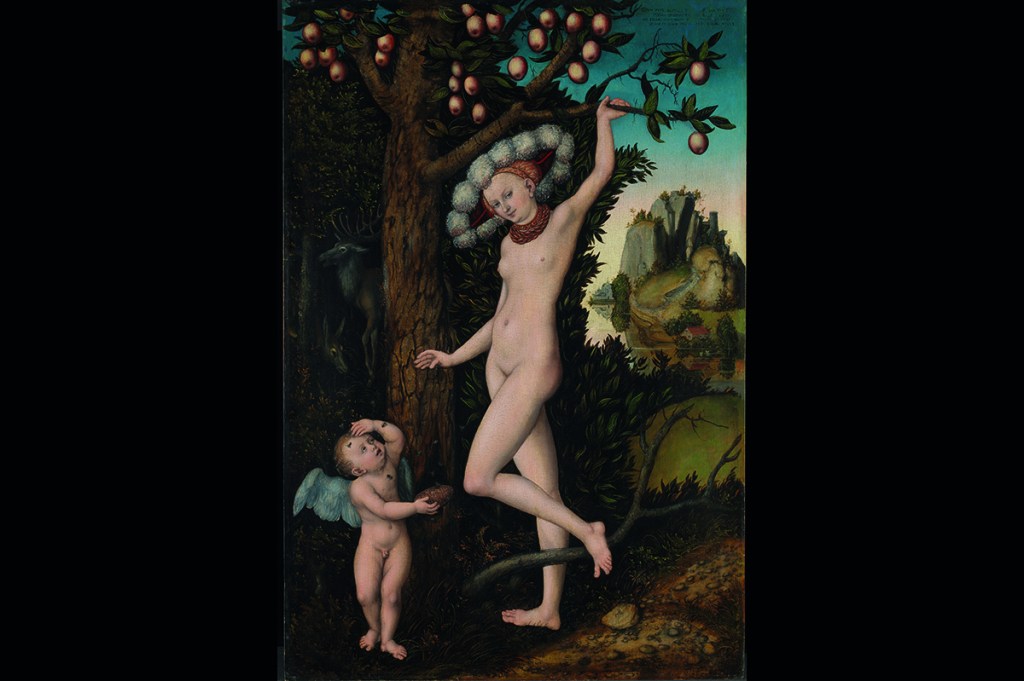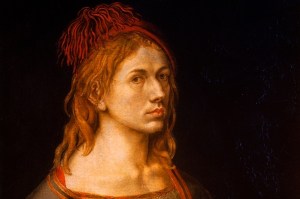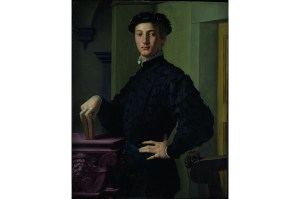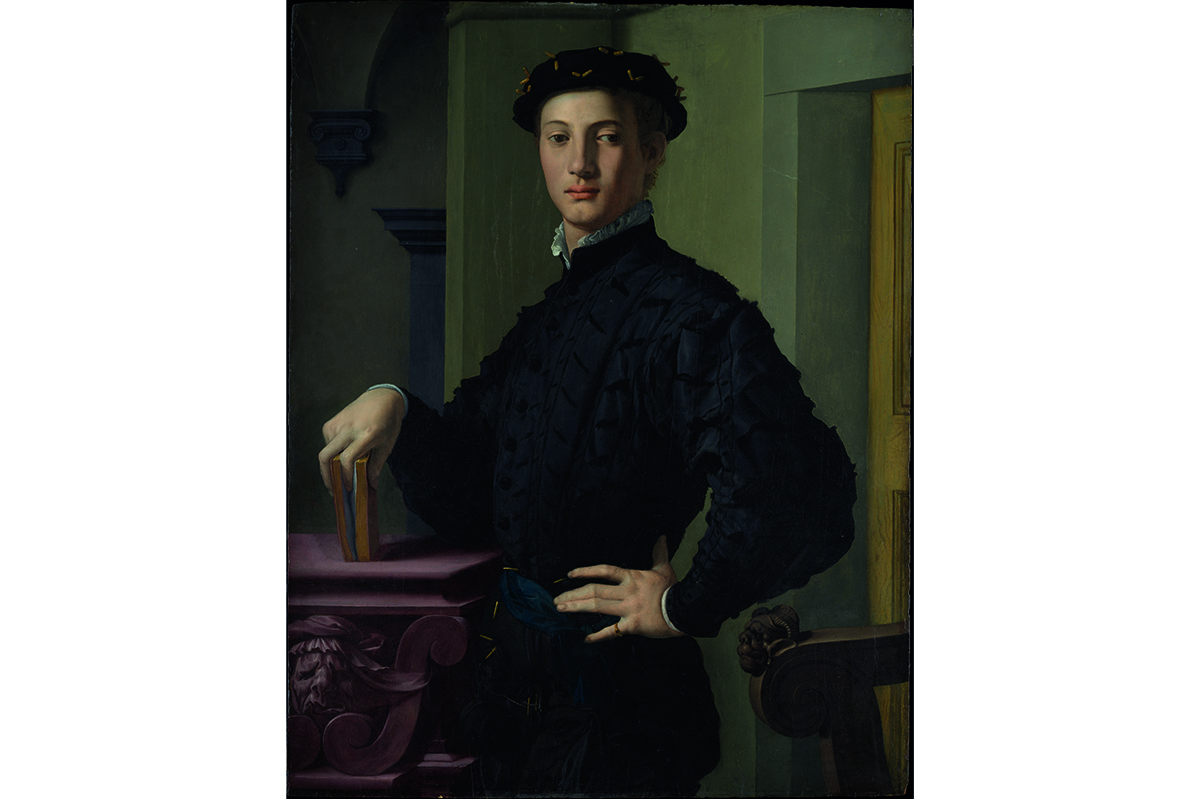‘Naughty little nudes,’ my history of art teacher used to say of Cranach’s Eves and Venuses. Aren’t they just? Coquettish and compact. Kenneth Clark thought they had ‘chic’. Cranach’s nudes are rarely truly naked. They wear Ascot hats, golden chokers, filmy wisps of gossamer girdle.
Take the goddess in the ‘Cupid Complaining to Venus’ (c. 1526-27) from the National Gallery, London. Don’t you long for her to take off her ostrich feather hat and tickle you with it? ‘Hallo, Jungs.’ See how she plays footsie with a branch of the tree. How she brushes the back of her hand against its trunk. Note the double necklace. Always accessorize.
‘Cupid Complaining to Venus’ has been lent to Compton Verney, an art gallery in a Warwickshire historic house, for what promised to be an enticing spring exhibition. Cranach: Artist and Innovator, like so much else, had to close before it had opened. You should have been there; you will be there: there is an excellent curator tour on the gallery website. While nothing beats seeing Cranach in the flesh — and such flesh! — the virtual tour is a fine appetite quickener while we wait for restrictions to lift.
We meet not only a painter, but also an entrepreneur and Reformation mover and shaker. Lucas Cranach the Elder (1472-1553) was court painter to Frederick the Wise, friend and publisher of Martin Luther, three times mayor of Wittenberg and one of the two richest men in the city. But why look at black-and-white books? You want the good stuff: the Dianas, the Venuses, the seductive sisters in ‘Lot and His Daughters’ (c. 1530) wearing scarlet and umber dresses in the same rich pigments as the distant, burning Sodom and Gomorrah.
The goddess in Compton Verney’s own ‘Venus and Cupid’ (c. 1525) is classic Cranach: sly and silken with sleepy, cat-like eyes, bee-stung breasts, minxy ankles, pinchable ears. An unseen wind machine lifts her curls. Cranach’s figures hold poses that are not quite natural: somewhere between the Gothic s-shape and the turn of the Renaissance contrapposto. The barest bend, a pop to the hip. In form, they recall sacred medieval Madonnas carved in tusks of ivory. In intent, they are profane. The Diana in ‘Apollo and Diana’ (c. 1526) sits on her stag as if it’s a dressing-room pouffe. She laces her fingers through her toes. A breeze catches the sash of Apollo’s bandolier and blows it across his arrowhead.
This exhibition reminds you, too, what a superlative painter of stuffs Cranach was. The puckered silks of Cranach’s unknown ladies in their pearl caps and power sleeves. The frou-frou feathers and knotted tassels worn in the double-portrait of Johann the Steadfast and Johann Friedrich the Magnanimous (1509), future electors of Saxony.
[special_offer]
Cranach paints with a gem-setter’s precision. Every glint on every bead set down. The velvet of Venus’s showstopper hat is done with whiskery, flickering hatchings. In ‘Portrait of a Lady and her Son’ (c. 1510-40), a tiny Nativity scene, perhaps an inch high, is set into a brooch. They’re all there: Virgin, Child, three Magi. A medallion shows Saint George raising his sword against a pinhead dragon. Cranach’s own signature was a winged serpent with a ring in its jaws. If you’re taking children, set them dragon-hunting. The sitter in Cranach’s ‘Portrait of a Woman’ (1525- 27) wears gloves slashed to show her rings. How bling is that? Cranach is gorgeous even when subdued. The jacquard black on black of the doublet worn in the portrait of Johann Feige (early 1530s), diplomat and first chancellor of Marburg University, is a tour de force.
The modern responses are mostly unsuccessful. Here are followers of Cranach, riffers on his themes, pale imitations of Cranach’s pale beauties. John Currin’s ‘Honeymoon Nude’ (1998) is a vacuous centerfold. Wolfe von Lenkiewicz’s mash-up of Cranach’s ‘Venus and Cupid’, Dürer’s ‘Adam and Eve’ and the flower paintings of the Dutch painter Ambrosius Bosschaert is tacky and flatly painted. Cupid’s webbed, aimlessly waving back foot is typical of the whole. Michael Landy’s ‘Saint Apollonia’ (2013), a tooth-pulling automaton, is effective, if one-trick. Landy does show up an omission: no Cranach saints, Passions or crowns of thorns. It skews the balance to the worldly. Ishbel Myerscough takes the Cranach theme of scalpel-edge nude against a black background and paints sympathetic but unsparing portraits of women far from the Venus ideal. Claire Partington’s downscale ceramic Venus and boxer-dog Cupid are clever and fun.
Only Picasso really holds his own. His lithograph ‘Venus et l’amour voleur de miel’ (1957) has an explosive energy. Venus’s hat becomes a flying saucer, her stomach bulges, her leg tapers into a fawn’s hoof. Picasso makes a mockery of Cranach’s see-through sarongs. In the linocut ‘Portrait of a Woman after Cranach the Younger’ (1958) Picasso takes Cranach’s necklace chains and sets up a rhythm that repeats and rotates through five colored blocks. Still, one would rather have the real naughty little deal.

























